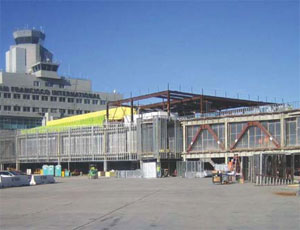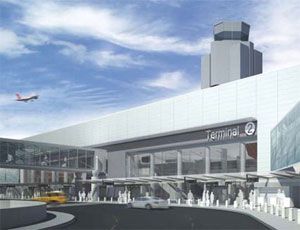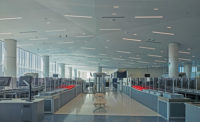... international terminal. Since then, Terminal 2 has been used to house the SFO medical clinic and airport and FAA administrative offices.


The 14 gates will serve predominantly narrow-body jets, but can accommodate Boeing 747-400-sized, wide-body craft.
The terminal will also include 30,793 sq ft of retail space, including a Peet’s Coffee and Tea shop, The Grill by Lark Creek sit-down restaurant, Napa Farms market, Xpres Spa, wine bar and about 17 other eateries and shops.
“The beauty of SFO is they use local businesses to fill their concession programs,” Perry says. “A lot of the same restaurants you’ll find in San Francisco are the same that will open in the airport.”
A pedestrian bridge will connect the terminal to AirTrain, a fully automated People Mover system that circles the facility and connects to Bay Area Rapid Transit. Terminal 2 will use SFO’s existing parking facilities adjacent to the facility.
Gensler of San Francisco was chosen as project architect for the terminal. Airport officials chose to tackle the project using the design-build process, in which the design and construction phases of a development overlap.
It’s only the second time the airport has chosen a design-build method of delivery for a project, says SFO project manager Ray Quesada, noting that a recent city ordinance allows the airport to use alternative building systems.
“Design-build lets us to develop, design and build this project much more quickly than had we gone through a more traditional design scenario,” he says. “It allows us to select contractors, or, in this case, a design-build team using a qualification-based selection process as opposed to a traditional design-bid build, which is based on the low bid.”
Quesada credits air carrier Virgin America’s selection of SFO as its home port for setting into motion of a chain of events that ultimately convinced the airport to move forward on the renovations.
“Virgin America looked at multiple cities and airports to decide which would be their base of operations,” he says. “They chose SFO primarily because we had this empty terminal that we were planning to convert to a domestic terminal once traffic picked up. Once that decision was made, Southwest decided to return, and then Jet Blue – which once said they would never use SFO until we got new runways -- decided that with Virgin America coming in, they’d better come in, too.”
The newly renovated gates are expected to service about 3.2 million enplaned passengers in the first full year of operations, with the capacity for servicing 5.5 million enplaned passengers annually.
Quesada and Perry express particular pride in the terminal project’s focus on environmental sustainability, which airport officials estimate will reduce greenhouse-gas emissions at the facility by about 1,660 tons per year.
The focus starts with the existing terminal itself. A substantial portion of the infrastructure will be reused for the remodeled facility, providing a one-time carbon-emission reduction of 12,300 tons.
Terminal 2 will feature a dual plumbing system for using reclaimed water in toilets and urinals. Preconditioned air and electrical power systems will service craft at all Terminal 2 gates, reducing jet fuel consumption by 1.4 million gallons per year.
Energy-efficient lighting and equipment are expected to reduce electrical demand by about 2.9 gigawatt hours per year and natural-gas consumption by about 116,000 therms per year. Plug-in chargers will be installed for ground-service vehicles. The airport will also allocate preferential parking spaces for electrical and hybrid cars and trucks.



Post a comment to this article
Report Abusive Comment